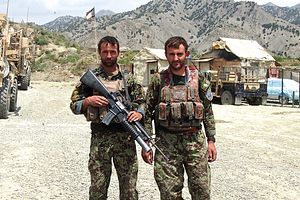This year’s fighting season in Afghanistan began with a vengeance. Last week, hundreds of Taliban fighters attacked army and police installations around the northern Afghan city of Kunduz. The battle is still raging, with heavy casualties on both sides.
Two weeks prior to the offensive in Kunduz city an estimated 1,000 Taliban fighters overran Afghan army positions in Jurm District in Badakhshan Province. Additonally, heavy fighting has been reported in several other provinces, including Sar-i-Pul, Jowzjan and Faryab the New York Times reports.
To make matters worse, the Islamic State (IS) may be making headway into the country as illustrated by a recent suicide attack in Jalalabad on April 18, although the Afghan Analysts Network cautions that IS “has been prominent in Afghanistan largely on social media and in reports by the media and Afghan officials.”
The New York Times notes that the Taliban’s move against Kunduz is the cornerstone of his year’s Taliban spring offensive. Ever since the withdrawal of the German Bundeswehr in October 2013, the security situation has deteriorated in the province.
“This is the worst situation in Kunduz since 2002,” emphasized the province’s vice-governor Hamdullah Daneschi according to Bild Zeitung. “The Taliban have become stronger and they will conquer the entire province should our security forces not receive reinforcements from the capital.”
Muhammad Yousuf Ayoubi, the provincial council chief, reiterated the vice-governor’s deep concerns: “Kunduz city is surrounded from four directions. If the government does not pay urgent attention, there is serious risk of it falling to the Taliban.”
Large numbers of foreign fighters including Uzbek, Tajik, and Chechen militants have allegedly joined the assault against government forces in the province. “Many foreigners have joined local Taliban groups. They are especially brutal and have experience with attacks and the abduction of foreigners,” according to a village elder quoted in Bild am Sonntag.
A military base with 450 soldiers in Iman Sahib, a Northern district in Kunduz province, is currently under siege by Taliban militants and has to be re-supplied by Afghan army helicopters. However, during a press conference today in Kabul, Dawlat Waziri, deputy spokesman for the Afghan Ministry of Defense, stated that the Afghan Security Forces are strong enough to withstand the Taliban onslaught.
“No district or province will collapse and I assure you that security forces are capable enough to control the situation,” he noted while citing the launch of three Afghan military operations in Badakhshan, Ghazni, and Zabul provinces against insurgent forces.
As of now, the Afghan National Security Forces are not in need of NATO support the Afghan Ministry of Defense emphasized. “So far we have no need for Resolute Support Mission help,” Waziri said.
General Wilson Schoffner, deputy chief of staff of communications for the Afghan Resolute Support Mission confirmed this statement noting that the Kunduz crisis is under control: “They have strong and capable leadership in place and have a very good plan to deal with the situation.”
However, Reuters reported that U.S. fighter jets were dispatched to the region on a mission outside regular operations. “We can confirm there were U.S. jet aircraft flying in the Kunduz area in the past 72 hours, no munitions dropped,”said a U.S. military spokesman. One can assume that NATO and U.S. forces are monitoring the developing situation closely ready to intervene at a moment’s notice.
According to a report released by the office of John Sopko, the special inspector general for Afghanistan reconstruction (SIGAR) the United States and NATO have no clear idea how many Afghan soldiers and police are currently engaged in combating Taliban insurgent (see: “Pentagon Declassifies Information on Afghan Security Forces”).
“Neither the United States nor its Afghan allies truly know how many Afghan soldiers and police are available for duty or, by extension, the true nature of their operational capabilities,” a newly released report by his office stated.
The United States has so far spent $60.7 billion to train, equip and pay 195,000 members of the Afghan army and 157,000 members of the police force. However, the number of troops and police is not reliable according to SIGAR. Despite recent setbacks, I am still standing by my assessment from the beginning of the year (see: “Can the Afghan Army Prevail on the Battlefield?”):
I am confident that the ANSF will be capable of prevailing on the battlefield against insurgents until 2017. It is important to understand that the insurgency is still very limited in its military capabilities and has been severely weakened by an aggressive coalition air campaign. The long term ANSF funding situation remains critical but is unlikely to change until 2017. ANSF will be able to control all major population centers and transit routes until then.
For an additional assessment on ANSF’s capabilities listen to our Podcast with Col. James L. Creighton (U.S. Army, Ret.) “Is Afghanistan Prepared for 2015 and Beyond”.

































